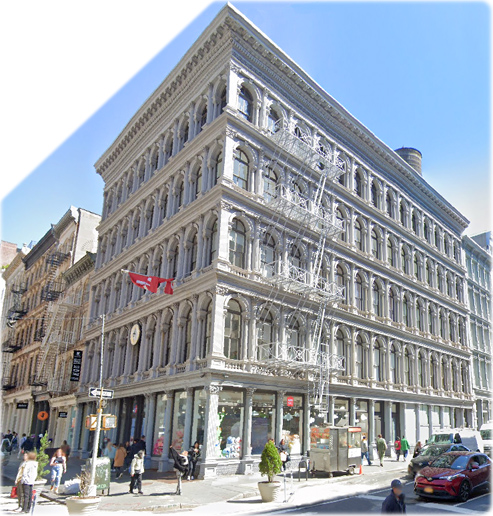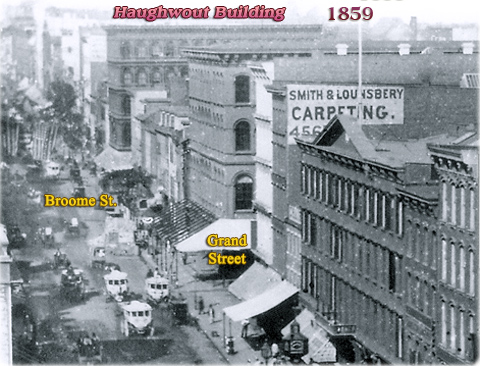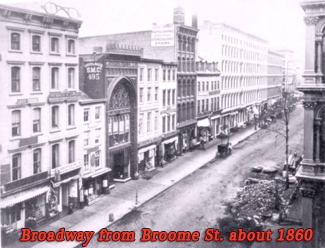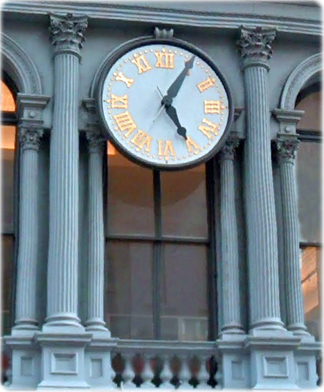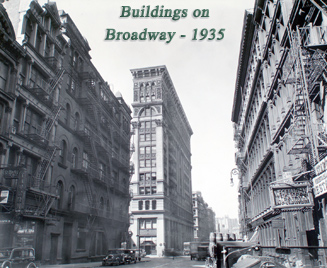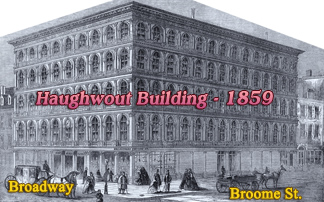The
historic Haughwout Building is a five-story loft building located at 488-492
Broadway, northeast corner of Broome Street, built in 1856-1857. It originally housed Eder V. Haughwout's
emporium. It was designated a New York City landmark in 1965.
Eder V. Haughwout was a crockery dealer in New York since about 1832. Since the 1830s, the large establishment of Woran & Haughwout was housed at 561 and 563 Broadway, near Niblo's. In February, 1852, William Woran was replaced by William I.F. Dailey in partnership with Eder V. Haughwout. The firm Woran & Haughwout was dissolved and the firm Haughwout & Dailey was created with William Woran as a special partner. The general nature of business of the new firm was importing, buying, dealing in and selling of China, glass lamps, gas fixtures, gas pipes and other house furnishing and fancy goods. The E. V. Haughwout & Co. was created before 1857 and it was located at 561 Broadway until it moved to the new Haughwout Building.
Construction of the Haughwout Building was announced on May 5, 1856, in the New York Herald. The site at 488, 490 and 492 Broadway (63 feet on Broadway and 100 feet on Broome Street) was previously occupied by three mansions and it was owned by William B. Astor. It was bought by John Jacob Astor in 1802. The E. V. Haughwout & Co. leased the site for 21 years.
The Haughwout Building was design in 1856 by architect John P. Gaynor (c. 1826–1888), who was born in Ireland and immigrated to the United States in 1849. The fire-proof five-story building was designed in an Anglo-Italianate style, with storefronts of cast-iron painted of a dark green, with Corinthian columns and arched windows set between columns. The iron structures were provided by Daniel D. Badger's Architectural Iron Works. The new building contained the world's first permanent steam passenger elevator. It was built by Elisha Otis and had an automatic safety device.
In February and March, 1857, there was the closing sale at the old store at 561 and 563 Broadway. The E. V. Haughwout & Co. was removed to the new store by March, 15.
The E. V. Haughwout & Co.'s new store opened for inspection on March 23, 1857, Monday evening. The manufacturing department occupied the 4th and 5th stories of the building, with painting and gilding of porcelain, glass cutting and engraving, manufacturing of pearl and ivory table cutlery, silver plating and mirrors. Among the goods there were bronzes and clocks, French, China dining, tea and toilet services, gas fixtures, silver-plated ware, pearl and ivory-handled table cutlery, China vases and more.
Eder V. Haughwout and others founded the Union Dime Savings Bank in April 1859. He was its first president and continued as such until 1867. It was located at 429 Canal Street, corner of Varick St.
During the Civil War (1861-1865), the southern trade was suspended and crockery and glassware trade, anywhere in the country, declined. In May 1861, Mary Todd Lincoln was in New York at the Metropolitan Hotel and ordered a dinner service in the establishment of Haughwout & Co. A vast amount of articles were sold at reduced prices and many others were disposed for the benefit of the poor.
Eder V. Haughwout retired in 1869 and the E. V. Haughwout & Co. store, on Broadway and Broome St., closed in April, 1870. After May 1, the business was succeeded by Nicol & Davidson at 686 Broadway, near Great Jones Street. In the same month the old store was offered to let. The E. V. Haughwout & Co. continued at 25 Park Place as general agents and commission merchants.
In the 1880s, the building was occupied by the E.H. van Ingen company and it was converted into a loft about the 1890. About that time a fire escape was installed on the Broome Street front. A new elevator was installed in 1892. Haughwout Building was sold on March 5, 1895, then owned by the estate of Walter Langdon. In the late 19th century, it was occupied by the Shoninger Brothers and L.V. Holzmainster Co. (glove manufacturing, founded in 1896). In the early 20th century the building housed stores of M.H. Pulaski & Co., Kursheedt Mfg. Co. and Sidney Bernheimer & Co. Later, it was occupied by the Princely Mills. The Broadway Manufacturers Supply Co. leased the building in September, 1936. It was restored in 1995.
